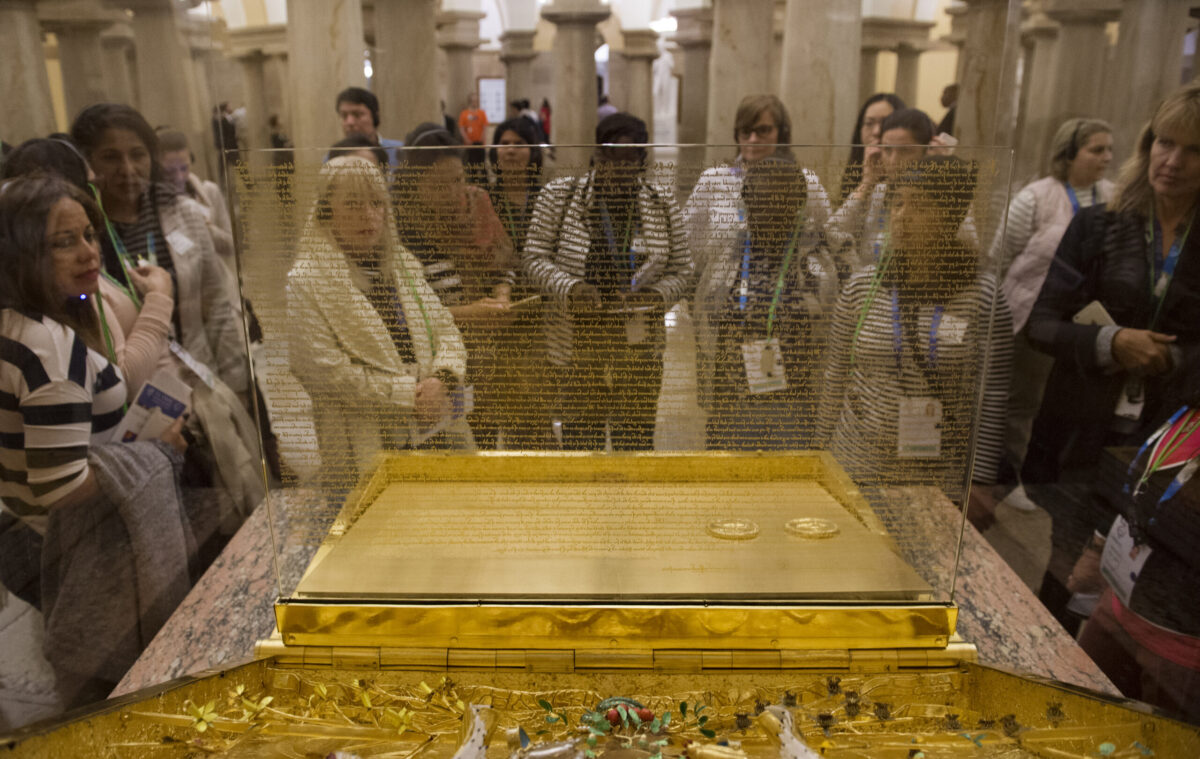The crypt of the U.S. Capitol isn’t the dark, dank dwelling conjured up by its evocative moniker. On the contrary, the crypt is a well-lit circular chamber on the ground floor, under the rotunda, traversed by countless people every day, hurrying on their way—blinders on—to a hearing or meeting of reputed import. George Washington was supposed to be interred here—hence the name of the burial place—but his body never made it. Construction of the crypt was interrupted by the War of 1812. His family decided to honor his wish to be buried at his Mt. Vernon, Virginia, home, just a few miles away from the Capitol.
Magna Carta
Tucked away in the crypt—hidden in plain sight—is a replica of the Magna Carta, the 800-year-old document reining in the monarch. On tours, I make a point of directing my visitors’ attention to this transformational declaration; otherwise, they might miss it, given all the magnificent distractions surrounding it—forty neoclassical columns, and thirteen statues of prominent Americans of the original thirteen colonies.
In all the times I’ve entered the crypt—and it’s been plenty—I’ve never seen people clustered around the gold and glass case containing this most essential document, the greatest relic in the room.
The history of the Magna Carta predates our nation’s founding by more than five hundred fifty years, which might explain how it sometimes escapes people’s attention today. King John of England signed the Magna Carta on June 15 of 1215, after a severe clash with his barons, who had become frustrated with the monarch’s arbitrary rule and abuses of power. The noblemen set out to craft a document to rein in the king’s powers. The document they formulated prohibited arbitrary arrest and imprisonment, and established individuals’ right to a fair trial and the protection of private property. Those rights are foundational to the rule of law, and essential for limiting the powers of government.
The Magna Carta—Latin for “the Great Charter”—provided the key principles of the supremacy of the rule of law that formed the foundation of our Constitution. In this respect, it is symbolic that the Magna Carta replica lies in the crypt—the literal foundation—of the Capitol, erected to support the rotunda above it. The document’s most important principle— that no man is above the law, not even the king—is the foundation for American rule of law, and the base upon which we have built our system of government.
If those basic rights recognized in the Magna Carta sound familiar, it’s for good reason. America’s founders drew heavily from the ideas in the Magna Carta to write the American Declaration of Independence and the Constitution.
The Compass Star
Only a few feet away from the Magna Carta is a worn white marble stone compass star embedded in the center of the floor of the crypt. While it may seem, at first glance, the two features of the Capitol are unrelated, they each reinforce the primacy of the rule of law and the importance of the legislative body.
That compass star is the point in Washington, D.C. where all four quadrants of the district—northeast, southeast, northwest, and southwest—converge. If you place your foot on the compass, as I have from time to time to demonstrate for my visitors, you are standing in all four quadrants of the city simultaneously. When I take tourists to this spot, the following ritual tends to take place: They stand on the star, which droops below floor level, smoothed down with the passage of time. Then they hop off the star, pull out their smartphones, and take photos of what is, admittedly, a cool symbol. But it holds even greater significance. The compass star is the key to understanding the vital role the legislature plays in our republic.
L’Enfant
We must first revisit Pierre-Charles L’Enfant. After he wrote to President George Washington, offering to create a capital “magnificent enough to grace a great nation,” he got the gig in 1791. Influenced by the France of his youth, L’Enfant borrowed ideas from the grand sweep of the Versailles palace, conjuring up what are now distinct D.C. features, such as its broad avenues, designed on a slashing angle. The cheerful L’Enfant sought another epic brush stroke, designing a considerable park in front of the White House, for the benefit of the president, whoever happened to be in residence. But Thomas Jefferson put the kibosh on those plans out of a worry such an exclusive domain didn’t mesh with the nascent nation of the people. Hence, the space became a public gathering spot you might have heard of—Lafayette Park.
L’Enfant, though, got his way on a more vital part of his plan, to make the Capitol the central point of the new capital district. The Capitol was created to be the central focus of the new government, a building perched on a slight hill, elevated above the rest of the city. That hill was known in our nation’s earlier years as “Jenkins Hill,” because a man named Thomas Jenkins apparently once grazed livestock at the site. L’Enfant saw it in a more enchanted way, as “a pedestal waiting for a monument.” That pedestal has come to be known as Capitol Hill, today.
The location of the Capitol building speaks volumes about the role our founders intended the legislative branch to play—and the paramount role of the rule of law. Because the Capitol is located on a hill, on one of the highest points in Washington, D.C., it reminds all of us that the legislative branch—the part of the federal government most accountable to the people—is the most important branch of government.
Excerpted from the 2020 book “Capital of Freedom, Restoring American Greatness” by Colorado Rep. Ken Buck




